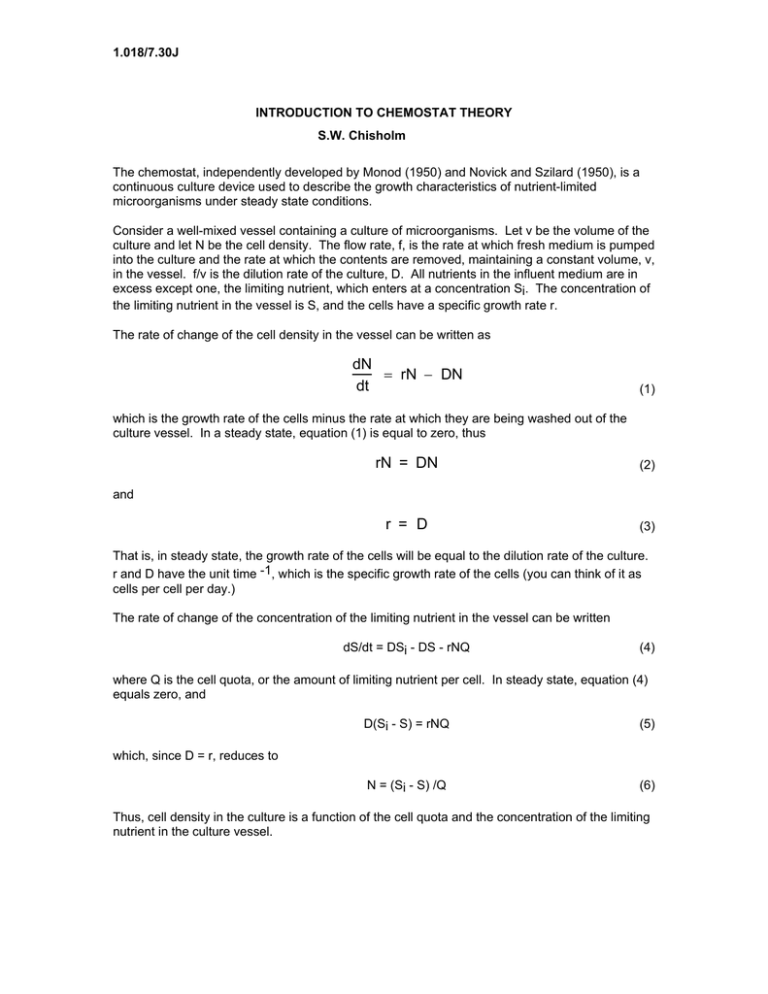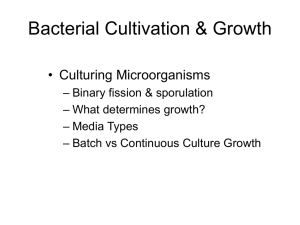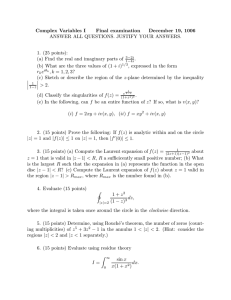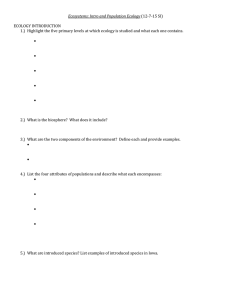1.018/7.30J INTRODUCTION TO CHEMOSTAT THEORY S.W. Chisholm
advertisement

1.018/7.30J INTRODUCTION TO CHEMOSTAT THEORY S.W. Chisholm The chemostat, independently developed by Monod (1950) and Novick and Szilard (1950), is a continuous culture device used to describe the growth characteristics of nutrient-limited microorganisms under steady state conditions. Consider a well-mixed vessel containing a culture of microorganisms. Let v be the volume of the culture and let N be the cell density. The flow rate, f, is the rate at which fresh medium is pumped into the culture and the rate at which the contents are removed, maintaining a constant volume, v, in the vessel. f/v is the dilution rate of the culture, D. All nutrients in the influent medium are in excess except one, the limiting nutrient, which enters at a concentration Si. The concentration of the limiting nutrient in the vessel is S, and the cells have a specific growth rate r. The rate of change of the cell density in the vessel can be written as dN = rN − DN dt (1) which is the growth rate of the cells minus the rate at which they are being washed out of the culture vessel. In a steady state, equation (1) is equal to zero, thus rN = DN (2) r = D (3) and That is, in steady state, the growth rate of the cells will be equal to the dilution rate of the culture. r and D have the unit time -1, which is the specific growth rate of the cells (you can think of it as cells per cell per day.) The rate of change of the concentration of the limiting nutrient in the vessel can be written dS/dt = DSi - DS - rNQ (4) where Q is the cell quota, or the amount of limiting nutrient per cell. In steady state, equation (4) equals zero, and D(Si - S) = rNQ (5) N = (Si - S) /Q (6) which, since D = r, reduces to Thus, cell density in the culture is a function of the cell quota and the concentration of the limiting nutrient in the culture vessel. Monod (1950) showed that the growth of bacteria limited by a single substrate can be described by the equation r = rmax S/ (Ks + S) (7) where rmax is the maximum possible growth rate of a species and Ks is the substrate concentration at rmax/2. Since D = r, equation (7) can be rewritten as S = Ks D/ (rmax - D) (8) N = [Si - Ks D/rmax - D] / Q (9) Combining equations (6) and (8) yields Thus, in a system where Q is a constant, if Ks, rmax, and Q are known for a given species, steady state values of N and S can be predicted for any dilution rate using equations (8) and (9). r = hr-1 specific growth rate of cells N = cells ml-1 cell density Si, S = g ml-1 influent, effluent dissolved concentration of limiting nutrient Q = g cell-1 cell quota - amount of limiting nutrient in the cell Y = 1/Q cells g-1 D = day-1 = f/v yield coefficient f = ml day-1 flow rate V = ml volume of culture dilution rate Novick, A, and L. Szilard, 1950. Experiments with the chemostat in spontaneous mutations of bacteria. Proc. Nat. Acad. Sci. 36:340-345. Monod, 1950. La technique de culture continue theorie et applications. Annls. Inst. Pasteur, Paris,79:390-401. 2 MIT OpenCourseWare http://ocw.mit.edu 1.018J / 7.30J Ecology I: The Earth Fall 2009 For information about citing these materials or our Terms of Use, visit: http://ocw.mit.edu/terms.






